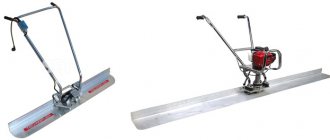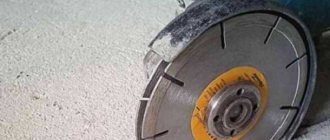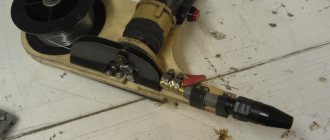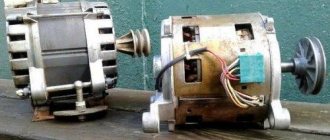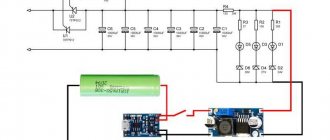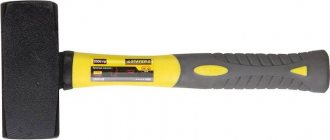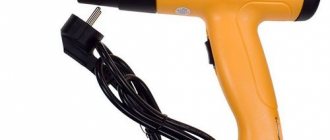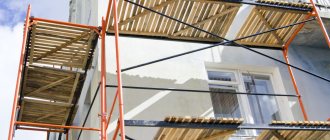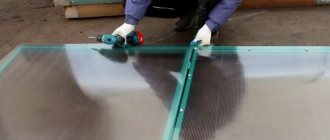Definition and purpose
The unit, which is based on a drive device that drives the abrasive belt, is called a grinder. They are classified according to the following criteria:
- purpose;
- areas of application (industrial or for individual use);
- nature of execution (stationary, manual);
- production method (industrial devices or self-made ones).
The main tasks that can be solved using the machine include:
- removal of roughing residues (burrs, remaining sharp edges, various protrusions);
- surface grinding;
- removal of the effects of corrosion and old paints and varnishes;
- sharpening knives and cutting tools.
All of the above tasks are solved by a professional grinder. This machine has advanced capabilities. They are usually performed in combination with several abrasive devices (for example, a belt and a disk).
Scheme and principle of operation
Structurally, any belt grinding machine consists of the following elements:
- Electrical engine;
- pulley with fixed straight roller;
- tension rollers;
- rotary clamping mechanism;
- abrasive tape;
- base.
To expand the functionality of the unit, individual designs have additional elements that allow work with heavily contaminated or deeply corroded surfaces. In this case, an abrasive disc is installed on the motor drive shaft.
A homemade grinder is assembled according to a similar scheme as a professional one.
The basic principle of operation of such a grinding machine is to drive the abrasive belt using a roller system.
It consists of a main video, which is the leading one. It is fixed to the motor shaft. The remaining rollers are secondary or driven. They have an adjustment mechanism that allows you to change the tension of the tape. To change the angle of inclination, the grinder has an adjustment mechanism.
The engine for the grinder is selected based on the list of work that is planned to be performed, productivity and degree of load. The industrial version is equipped with an engine designed in accordance with the specified parameters. It allows you to obtain the required belt speed, as well as uninterrupted operation for a long time. The value of this parameter is determined by the engine shaft speed and the size of the pulley. The most optimal belt speed is considered to be about 30 m/sec. To simplify obtaining the necessary parameters, a summary table has been developed. With its help, you can find the desired belt speed depending on the speed of the selected engine. It can be accurately calculated using known formulas and table data.
In modern literature and Internet portals you can find drawings with dimensions of various grinder designs. When choosing the layout and design of a future device, you need to evaluate your capabilities for purchasing or manufacturing each element of such a unit. For example, what kind of electric motor is planned to be used. Determine the required dimensions of the entire product. What type of tape do you plan to use in your work?
Schematic diagram of the grinder design
The Internet contains many images of 3D models, drawings, sketches and even assembly drawings of grinders of various designs. Each of them has its own characteristics, but in principle they all consist of several main components (see figure below):
- Drive with electric motor.
- The bed is on a stable base.
- Drive pulley.
- Tension roller with tension adjustment mechanism.
- Guide rollers (usually one or two).
- Device for moving and tilting guide rollers.
- Support table.
Before you start designing your grinder, you need to decide on the range of lengths of sanding belts that you plan to use. Both the overall size and layout of the future machine, as well as the characteristics of the tension mechanism and the device for moving the guide rollers, depend on this parameter. The length of the tape used is equal to the sum of the center distances, adjusted for the dimensions of the pulley and rollers, and must take into account the strokes of the adjustment and tension mechanisms.
One of the key points when designing a grinder is calculating the linear speed of the grinding belt, which directly depends on the engine speed and the diameter of the drive pulley.
When grinding various materials, it is necessary to take into account that each of them has its own physical characteristics and therefore must be processed at a certain speed. The maximum grinding speeds for the most common materials are approximately equal (or close), but the lower limits vary significantly (indicators in m/s):
- hardwood and plywood - 15÷30;
- varnish coatings - 5÷15;
- soft and coniferous wood - 12÷20;
- carbon steel products - 25÷30;
- plastics - 10÷20.
When making a grinder with your own hands, as a rule, old electric motors from household appliances are used (most often from sewing and washing machines), or hand-held power tools (drills and grinders) are used as a drive. That is, the home master is limited in advance in choosing the engine rotation speed, so for him the main design parameter in the design of his machine is the diameter of the drive pulley, on which the linear speed of the sanding belt directly depends.
The drive pulley diameter (in mm) is calculated using the following formula:
Here V is the required speed of the abrasive belt in m/s, and N is the rotation speed of the drive pulley in rpm. Below is a table of the dependence of linear speed on this diameter.
When using your own electric motor to reduce or increase the rotation speed, you can make a drive with a belt drive and pulleys of appropriate diameters. For range control, a stepped pulley is usually used or several replaceable pulleys are made. But the best choice for these purposes is a frequency regulator, the description and diagrams of which can be easily found on the Internet.
If the drive is a power tool, then perhaps the most suitable option would be a simple electronic controller. Such a device is inexpensive - 500–800 rubles, but along with the speed it significantly reduces power.
Advantages over a sharpener
The belt grinder has a certain number of advantages compared to other tools designed for sharpening and grinding. Compared to a sharpener, it has the following advantages:
- expanded capabilities for surface treatment, including for parts of large sizes and weight;
- improved capabilities for positioning the tool relative to the surface being processed;
- uniform grinding of the abrasive coating of the belt (unlike wheels on a sharpener)
- simplified abrasive replacement system.
The wider capabilities for surface processing that are inherent in belt grinding machines are expressed not only in the processing of large-sized parts. Even the simplest model is capable of processing second- and third-order surfaces, such as pipes, fenders and car bodies.
The correct selection of belts allows you to carry out all stages of processing: rough sharpening, grinding, polishing.
The abrasive wheel with which the sharpening machine is equipped wears unevenly during operation. This leads to a violation of its geometry, and therefore, the accuracy and quality of processing.
However, grinders have two disadvantages associated with their design. The first refers to lower reliability. This is due to the presence of a more complex mechanism for setting the belt in motion: bearings, shafts, tension springs, and the belt itself. The machine only has a motor and an abrasive wheel.
The structural complexity requires periodic inspection and maintenance. Wear of the bearings leads to imbalance and, as a consequence, to uneven adherence of the belt. Long-term use of the grinder changes the geometry of the shafts. They change from cylindrical shafts to oval ones.
Grinders from Chapai
Currently, a large number of designs of belt grinding tools are offered in the literature and on the Internet. Some of them are considered more successful, others are difficult to implement.
The designs of grinders from Chapai are recognized as one of the successful developments. Developer Andrey Chapai offers professional tools and versions for the home workshop. One of the significant advantages of these models is the wide range of machining angles. To solve this problem, the author proposed an original design of a rotary table. This design formed the basis of all grinders in the professional line. These include: GC 10, GC 12 and GC 16. They received a fairly high rating among specialists. To expand the functionality, the author equipped his products with a device for mounting a disk. A rotating frame assembled from two metal sheets 12 millimeters thick ensures high reliability of the entire tool.
In addition to professional versions, Chapai has developed mobile versions (GCh610-63 and GCh610-71). They are easy to use and demonstrate good consumer characteristics.
Grinders from Rustam
The most common model is GR-1. They are equipped with two types of motors: single-phase or three-phase. The grinder from Rustam has a 1.1 kW motor. This power is quite enough to provide the necessary characteristics. The developed design uses rollers that are coated with a layer of propylene. This significantly reduces noise levels and reduces heat during rotation.
The original design of the rotary table allows processing of parts of various geometric shapes.
Making a grinder with your own hands
The high prices for devices of this type encourage many to make a machine with their own hands. To implement such an idea, you need to understand how to make a grinder in a home workshop. To this end, consider the following points:
- what problems are planned to be solved using such a unit;
- choose a scheme that meets the requirements;
- select components (according to the diagram);
- how and with what tools and equipment to carry out the assembly.
You can make a stationary or manual grinder yourself. In all cases, a device must be developed capable of transmitting rotational motion from the motor shaft to the drive and driven rollers. They, in turn, force the abrasive belt to move in a circle. Almost any electric motor can be used in the design. For example, use a motor from a vacuum cleaner. Experience in operating such units has shown that it is desirable to have a belt speed control system. This increases the efficiency of its use. For this purpose, you can use a ready-made frequency converter or a stepper switch.
You can place the grinder on the sandpaper. This greatly simplifies the task. To create a rigid structure, it is advisable to provide for the insertion of a metal corner. It will give the structure the required rigidity. Drive and driven rollers can be made from various available materials. For example, made of wood, plastic, duralumin, profile pipe.
The most important conditions for their production are strict adherence to the geometric shape and ensuring the necessary surface roughness. For a grinder, this indicator should be in the range from Ra 1.25 to Ra 2.5. Increasing the roughness will lead to rapid wear of the belt. Reducing it will cause slippage and malfunction of the grinder. This will not allow for high-quality metal processing. When using emery as a basis for a grinder, the listed features must be taken into account.
In addition, it is necessary to provide for the possibility of protecting the roller and bearings from particles of material formed during grinding. Contamination of these elements will lead to failure of each of them. You can ensure reliable fastening of the rollers using standard cotter pins or using a specially made pin.
From the Bulgarian
The simplest and most common design is the grinder made from an angle grinder. The motor and electrical control circuit located on the grinding machine are used as the basis. To set the abrasive belt in motion, a special nozzle is made. It consists of two shafts and a fastening system. The grinder for the angle grinder is an additional accessory. To assemble a grinder from an angle grinder with your own hands, you need to make individual structural elements yourself.
Ready-made structures can be found from 125 angle grinders. They are installed on the grinder, creating a belt mechanism for using a standard abrasive belt. The horizontal mechanism allows you to provide the necessary characteristics of the grinder.
With a washing machine motor
The main element of grinding machines is the engine. It can be selected independently from other electrical appliances. One option is a homemade grinder with a washing machine engine. The use of such a motor requires the creation of a reliable frame and a fastening system for all elements.
They make a finished unit from a washing machine motor with their own hands, having previously calculated the rotation speed of the belt. This can be done by knowing its characteristics: engine power and speed. If the rotation speed is too high, it is necessary to develop an electronic engine control system.
Usually, to simplify the task, they use the engine of a small washing machine. This greatly simplifies the task of making a grinder with your own hands. Such grinders are made to fit a standard belt size of 75 mm wide and 475 mm long.
From a drill
A grinder from a drill can be made using a set of simple tools. In this case, he presents a special attachment for the cartridge. Made by hand, they are designed to perform simple surface cleaning and sanding work. Craftsmen have accumulated vast experience in creating such structures. Having the simplest skills in plumbing, you can independently develop a diagram of the unit and make it with your own hands.
The use of a drill allows you to create stationary structures on a frame and portable ones. In this case, the drill is not attached to the machine, but is transferred to the surface to be processed.
From a sander
The most common are grinder schemes in which a grinding machine is used as a motor. To implement these schemes, it is necessary to manufacture a drive and driven shaft, a frame and a system for adjusting the tension of the abrasive belt. A do-it-yourself grinder from a grinding machine can be quickly made in a home workshop. A grinding machine mounted on a frame allows you to get a high-quality stationary grinder for solving a wide range of tasks related to sharpening and grinding.
Step-by-step manufacturing instructions
Stage 1. Device body
We will need:
- an angle grinder will be used as a drive;
- pipe 15 mm with a square profile;
- four-millimeter metal strip.
- First, bend the metal strip to the diameter of the grinder.
- Let's start welding work. Press the rim to a flat surface and place a square with a side of 2 cm at a right angle.
- We check the corners and you can grab and scald.
- You can clean all the seams, but this step is not necessary.
- Now you need to cut a thread with a diameter of 4 mm in the place where the ferrule is tightened. To do this, we core and drill.
- Using an angle grinder, we cut the workpiece so that the clamp can be crimped.
- On the reverse side, we drill a hole for the body of the bolt so that it fits freely in this half and is screwed into the other.
- Let's try on the body. If nothing is loose, then you can continue.
- At this stage it is necessary that the leading video is ready. We weld the profile pipe perpendicular to the roller, having previously determined its middle.
- We clean and polish.
Stage 2. Leading video
- You need to make small notches on the nut. This is done so that the carboxyl resin runs through them and better holds the nut when rotating.
- You need to make small notches on the nut. This is done so that the carboxyl resin runs through them and better holds the nut when rotating.
- We dilute the resin and pour it. Cover the reverse side with masking tape, otherwise the glue will leak out.
- We begin processing only after 24 hours. Using a rasp, we begin to shape the roller.
- We clamp the grinder in a vice and continue. First we make the roller semicircular, later we will grind it until we get the desired shape.
Stage 3. Roller with tension mechanism
- As a basis we take a metal square with sides of 12 mm. It fits best under this profile pipe.
- We cut off unnecessary parts.
- We put a piece of profile pipe on the edge of the square and scald it. A bearing will be fixed in it, which will act as a roller.
- We drill a hole with a diameter of 8 mm for the bearing shaft and shorten the part.
- Now you need to cut off 2 walls of the profile pipe to fit the bearing.
- After the cut, we process everything with a file.
- An 8 mm drill can be used as a shaft. We insert the shaft into the roller and grab it.
- After making all the parts of the grinder, you can proceed to assembly. We insert the roller with the tensioner and put on the abrasive tape.
- This design still lacks a flat stop. We set the stop under the tape and you can grab it.
Video instructions for making
In addition to popular scientific literature, which provides design diagrams, calculation formulas and summary tables that help you choose the required grinder design. Find out how you can make such a unit with your own hands.
On popular Internet portals you can find video instructions for assembling and using the grinder. For example, you can find out this information by watching the following videos:
There are quite a lot of such links. Therefore, you can choose the most suitable video for making a grinder with your own hands.
Homemade grinder with a washing machine engine
With a drive pulley size of 70÷100 mm, the motor for the grinder must spin up to at least 3000 rpm.
According to their characteristics, asynchronous electric motors from old automatic washing machines with a power of at least 300 W meet this requirement (albeit not fully). These are quite simple, reliable and unpretentious devices, which are one of the most common used electric motors. Their output shaft has a threaded connection onto which a pulley to drive the grinder can be easily attached.
When using commutator motors from next-generation washing machines, you cannot do without a separate speed controller, since their rotation speed usually lies in the range from 11 to 18 thousand revolutions per minute.
These compact and powerful devices have their drawback: with constant use under load, their brushes quickly wear out.
In the video (see below), a folk craftsman demonstrates a self-made grinder with a motor from a washing machine, a convenient tensioning device, an electronic speed controller and rollers on bearings with a diameter of 65 mm (a tension roller from a Gazelle).
The result is a completely workable option with a high-quality and functional support table, which rotates ninety degrees and moves along guides.
How to make rollers for a machine
The rollers on which the abrasive tape is placed can be selected from ready-made samples. This approach can be implemented if such a possibility exists. In most cases, they make grinder rollers with their own hands. Their sizes range from 70 mm to 150 mm. It is determined by the width of the tape used. In this case, use the following approach:
- Select the belt tension mechanism.
- Dimensions of each roller.
- Select the material.
- Fastening methods.
The most affordable materials for making grinder rollers are wood or plywood, PVC blanks, and ready-made bearings. To make rollers from PVC pipes, select a blank whose internal and external diameters correspond to those specified in the drawing. The main disadvantage of such a roller is that at high rotation speeds the temperature increases. Therefore, the polypropylene roller may lose its original shape.
The production of such rollers from bearings comes down to their selection according to their internal and external diameters. Professionals advise choosing bearings of at least sixth grade.
In some cases, wood is used. For example, you can make your own rollers from plywood. The whole structure will be quite light.
The main condition is the requirement that the rotation loop of the abrasive belt must be reliable and durable. The tension roller for the grinder must have an adjustment mechanism that will provide the required degree of tension.
All rollers must be installed vertically. Even a slight change in relative position will cause the tape to break quickly.
Characteristics that a belt for a sanding unit must meet
Selecting an abrasive strip is an important step when assembling a mini-grinder with your own hands. First of all, you need to decide on the length of the tape and its width. The geometric parameters of the strip are influenced by two main factors:
- grinder dimensions;
- purpose of the unit.
Fabric base withstands surface tension better
Endless abrasive strips are also classified into grit types. The length of the sanding strips can be different (from 610 to 1830 mm). Such tapes have a width of 50 or 100 mm. The first option is most often found in units assembled by hand at home.
A high-quality abrasive strip must have an elastic fabric base
When choosing the right tool, you also need to pay attention to how many revolutions the strip can withstand. It is recommended to purchase products that can operate at 1500 rpm
This option is best suited for making a belt grinder with your own hands. The drawing drawn up earlier must contain information about the dimensions of the abrasive strip and its other characteristics.
A good tape must have high abrasive resistance. The wear resistance of the tape depends on this indicator. For homemade machines, it is recommended to use belts whose length is no more than 123 cm. The abrasive strip must not only be resistant to wear, but also have good resistance to high temperatures generated during friction against the workpiece during operation.
It is worth noting that short-length tapes are much more susceptible to wear than longer products.
Experts advise paying attention to pictures depicting finished products. Photos of the machines allow us to answer the question of how to make a grinder with your own hands
The design of the device can be significantly simplified if ready-made elements purchased separately are used in its assembly.
The speed and quality of product processing depends on the choice of tape.
And finally, special attention must be paid to the place where the abrasive tape is glued. The junction of the two ends of the strip should be as neat as possible, without any defects or protrusions
How to glue the tape for the sanding unit yourself
Belt grinders contain a spring, which performs a very important function: it tensions the belt that has sagged due to wear. The belt is changed several times even when processing a small workpiece. This should be remembered.
When assembling a grinder with your own hands from plywood or metal, you can make an abrasive strip yourself. Gluing such tape is a complex undertaking that does not tolerate mistakes. There is a lot of advice on the Internet on how to properly glue tape, but many of them are incorrect.
The gluing process is as follows. First you need to select a fabric-based sanding material. Then you should prepare both ends of the abrasive strip. To do this, they are cleaned. The seam on the strip is made exclusively using the butt method. Experts definitely recommend reinforcing the glued tape from the inside with a thick strip of fabric, which is fixed with a special adhesive composition.
Gluing tape is a complex process that does not tolerate mistakes.
In order to connect the ends of the abrasive strip, you need to purchase a special adhesive composition. The best option is to use elastic glue. There is no point in saving money, since cheap products, as a rule, are not of good quality.
Before gluing, it is necessary to prepare a strip for sanding tape. A do-it-yourself grinder (from scrap materials) needs a reliable abrasive strip, which is difficult to do at home. The process is carried out using a glue stick, which is installed on hot-melt guns. First, the composition is heated. To do this, you can use a regular hairdryer, which is found in every home.
Homemade pulley
This structural element is the most difficult to manufacture. A ready-made pulley for a grinder is quite an expensive part. To make it yourself, you need certain knowledge in the field of mechanics and turning. You can get a high-quality pulley from steel or duralumin. In this case, the workpiece must be processed on metal-cutting machines. In a simplified version, it can be made from plywood. It must be FSF or FB. The thickness is selected based on the width of the tape used.
The diameter of the drive shaft is calculated based on the characteristics of the selected motor and the required belt speed. You can make this calculation yourself or use existing tables.
Choosing a grinder belt
It is advisable to start selecting a belt grinder from the end, namely, to determine what width and height of the surface will be processed by grinding. Then compare these needs with the actual sizes of sanding belts that are commercially available.
As you know, endless sanding belts differ in their length, width and grit level. The size range of sanding belts of domestic and imported production, which are intended for use in grinders, is as follows: length 610, 915, 1230, 1600, 1830 mm, with a width of 50 and 100 mm. You can look for others, but subject to the unconditional fulfillment of the following requirements:
- The sanding belt must have an elastic fabric base;
- Maintain angular speeds of at least 1500 min -1 ;
- Possess high abrasive resistance;
- Allow relative elongation without rupture of the material of at least 10...15%;
- Minimum heating during prolonged continuous grinding.
It should be noted that for a homemade grinder, sanding belts with a length of no more than 1230 mm are better suited. Short belts wear out more because they do not have time to cool down during their idle movement, and longer ones automatically increase the dimensions of the machine without giving any visible advantages in return.
The mechanical strength of the tape material is also important. It is strictly not recommended to rely on composite tapes, even if glued with double tape: during operation, the joint stretches, and the tension of the tape weakens. Moreover, a sudden rupture of the tape with all the ensuing consequences is possible. Taking into account the fast speed of movement of the belt along the surfaces of the rollers, the specific grinding forces should not exceed 0.7...0.8 kg/cm 2 . This corresponds to the parameters of the mechanical strength of the electrocorundum tape within the range of 800...900 MPa.
It is important that before use the tape must be hung on a cylinder with a diameter of 50...60 mm for at least 48 hours. This will ensure natural elongation of the product before use.
Bonding tape
Modern manufacturers of abrasive materials offer ready-to-use belts. They can be in rolls of a given size or glued into a ring. Usually there is a need to make an abrasive belt for a grinder to specific sizes. This is done by gluing strips to a specific size. To solve this problem you will need the following materials:
- tape for gluing abrasive materials;
- glue;
- degreasing liquid (gasoline or white spirit);
- a clamp or weight for compressing glued parts.
The tape should be applied in the following sequence:
- Mark the strip of abrasive along its length, taking into account the joint, which is made at an angle. The larger it is, the longer the contact length.
- The backing of the required length is cut out of the braid. It ensures reliable gluing.
- The surfaces are prepared for applying glue: they are cleaned with sandpaper and degreased.
- Cover the substrate and part of the tape with glue.
- Gently press the substrate against the abrasive tape and fasten them together using the available tools.
If the gluing is done carefully, the homemade tape will last quite a long time. In terms of its consumer characteristics, it will be no worse than the samples produced at the enterprise.
Review of factory models and prices
The variety of factory-produced models creates great difficulties when choosing the required unit. The selection is made based on the following criteria:
- number of functions performed;
- technical characteristics of individual components and assemblies;
- at the price specified by the manufacturer.
The most appropriate approach is considered to be based on the “effectiveness – cost” criterion. Thanks to the correct definition of this criterion, you can choose an effective grinder at an affordable price.
Lefty
Belt grinder Leftsha 610 belongs to the category of professional machines. It operates from a three-phase 380 V or two-phase 220 V network. Possessing a rotating bed that can be rotated 90°, it allows processing of workpieces of various shapes. Grinder Levsha 610 provides a belt rotation speed of 15 m/s. This belt grinder is equipped with a 1.1 kW motor. It provides a rotation speed of 3000 rpm.
The manufacturer offers several modifications of its products: 610pro, mg 610a, Lefty 1250. Each of the listed models has its own design features. For example, the grinder Master 610 is designed to use a belt 610 mm long. Grinders from the company Mosgrinder have similar characteristics.
Energomash
The Energomash company offers grinders of its own production. Possessing a powerful production base, they manufacture a line of grinders designed to solve various surface treatment problems. Basically, this is professional equipment designed for different lengths of tape.
Bison
The Zubr grinding machine is classified as a universal portable machine. With two grinding tools (wheel and belt), it can solve almost any deburring and grinding task. Thanks to the angle stop and fixing the angle of inclination of the work table, it is possible to change the processing plane and ensure high accuracy. A special system for removing generated dust and processing products improves working conditions, reduces dust and fire hazards.
The provided protection system against inadvertent activation of the electrical circuit ensures compliance with safety regulations.
Grinderok
This company offers several types of grinding equipment that fall under the category of grinders. These include the following families:
- Gandalf;
- Frodo;
- Filit;
- Sam.
Each of the proposed tools has its own advantages and disadvantages.
One of the significant disadvantages is the price. It starts from 24,000 rubles and goes up to 41,000 rubles. To make the right choice from these families, determine the list of tasks that you plan to solve using the purchased machine.
Operation and design of the belt grinder
The principle of operation of the grinder is simple. There is a group of rollers through which a sanding belt of the required grit is passed. If you rotate the drive roller mounted on the output shaft of the electric motor, the others will automatically begin to rotate. By adjusting the relative position of the driven rollers, it is possible to grind surfaces with defects of varying depths. To compensate for the possible stretching of the belt (during its long-term operation), a mechanism is provided for tensioning one of the rollers (as a rule, the one that is located somewhere between the driving and driven ones in the kinematic chain of the machine).
The design of the belt grinder includes a table on which the product being processed should be fixed. It is better if such a table has the ability to rotate along one of the axes at an angle of up to 90º: then it is possible to grind two mutually perpendicular planes from one installation of the part. As a safety feature, it makes sense to provide a folding protective glass made of transparent acrylic on the machine frame - then there is no fear that flakes of sanded paint or scale will get into the operator’s eye. Naturally, you will need controls that are located in the bed or on the frame of the machine. Portable versions are equipped with a durable stand, on the base of which there are mounting holes, with which the grinder can be mounted on a workbench.
Read also: Free programs for creating block diagrams
Let's try to abstract from the elegance of design and color, and take a sober look at the design. The visual instability of the machine immediately catches your eye: the overhang of the cantilevered rollers is much greater than the supporting surface under the bed. In addition, the absence of a table does not allow processing relatively massive surfaces, which are simply inconvenient to keep in a canopy for a long time. The increased length of the belt (and the accompanying mechanical friction losses) becomes the reason for the use of increased power in the motor drive, and, consequently, energy intensity. The tension unit is elegant and easy to set up, and the machine comes with replaceable grinding attachments that allow you to grind even internal surfaces - but is it worth shelling out more than 100 thousand rubles for this?
